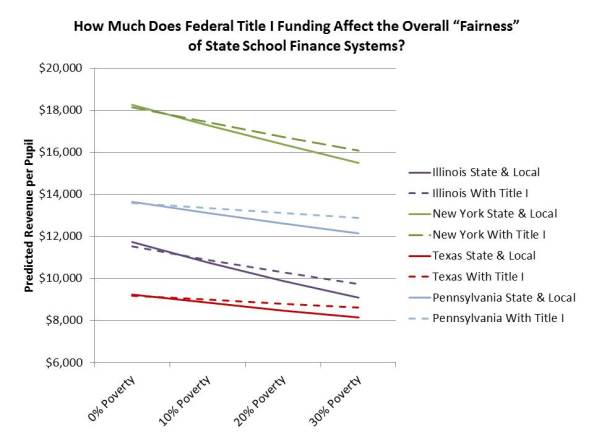How much does Federal Title I Funding Affect Fairness in State School Finance Systems?
About this much!
These funding profiles are based on the methodology used in our reports on school funding fairness. The reports can be found here: http://schoolfundingfairness.org/ and the technical appendix can be found here: http://schoolfundingfairness.org/
This graph is based on an updated model which includes data from 2007-08, 2008-09 and 2009-10 (these are linear projections of otherwise messy distributions… hence the fact that some of the lines cross at/around 0% poverty).
The bottom line is that while Federal Title I programs certainly provide much needed funds to many high poverty

These funding profiles are based on the methodology used in our reports on school funding fairness. The reports can be found here: http://schoolfundingfairness.org/ and the technical appendix can be found here: http://schoolfundingfairness.org/
This graph is based on an updated model which includes data from 2007-08, 2008-09 and 2009-10 (these are linear projections of otherwise messy distributions… hence the fact that some of the lines cross at/around 0% poverty).
The bottom line is that while Federal Title I programs certainly provide much needed funds to many high poverty
Friday Finance 101: What Can we Learn about Education Costs & Efficiency by Studying Existing Public Schools?
One pervasive reformy argument is that our entire education system may be instantly transformed to be more productive and efficient by instantly adopting untested reformy policies and/or untested solutions of sectors other than education. Further, that we must take these bold leaps of faith because the public education system itself is too corrupt, too bloated, too inefficient to provide any useful lessons! Perhaps the whole system can be replaced with you-tube videos. Or perhaps we can just fire all of the teachers with more than 10 years experience and pay the rest based on the test scores they produce! Or perhaps some other lessons of industry can cure the (unsubstantiated) ills of American public schooling!
Kevin Welner and I addressed this issue in our critique of materials provided on the U.S. Department of Education’s website on improving educational productivity. Specifically, Marguerite Roza and Paul Hill in one working paper titled Curing Baumol’s Disease argue that the entire public schooling system suffers from a disease of inefficiency and thus any lessons for improving educational productivity must be sought outside of the current system.
Similar arguments have been used by those who claim that state legislatures and state courts should never rely on cost analyses based on current practices of existing educational systems in order to either guide the design
Kevin Welner and I addressed this issue in our critique of materials provided on the U.S. Department of Education’s website on improving educational productivity. Specifically, Marguerite Roza and Paul Hill in one working paper titled Curing Baumol’s Disease argue that the entire public schooling system suffers from a disease of inefficiency and thus any lessons for improving educational productivity must be sought outside of the current system.
Similar arguments have been used by those who claim that state legislatures and state courts should never rely on cost analyses based on current practices of existing educational systems in order to either guide the design
Friday Finance 101: Equitable and Adequate Funding and Teacher Quality is Not an Either-Or choice!
In recent years, the casual observer of debates over public education policy might be led to believe that improving teacher quality and ensuring that low income and minority school children have access to high quality teachers has little or nothing to do with the equity or adequacy of financing of schools. The casual observer might be led to believe that there actually exists a sizable body of empirical research that confirms a) that high quality teaches matter, b) that money doesn’t matter and c) by extension money has nothing to do with recruiting, retaining or redistributing teacher quality. These arguments, while politically convenient for those hoping to avoid thorny questions of tax policy and state aid formulas, are not actually grounded in any body of decisive, empirical research. Rather, to the contrary, it is reasonably well understood that while teacher quality does indeed matter, teacher wages also matter and teacher working conditions matter, both in terms of the level of quality of the overall teacher workforce and in the distribution of quality teachers.
The modern debate over the role of teachers and teaching quality for improving student outcomes dates back to findings within the Coleman report in the 1960s. The Coleman report looked at a variety of specific schooling
The modern debate over the role of teachers and teaching quality for improving student outcomes dates back to findings within the Coleman report in the 1960s. The Coleman report looked at a variety of specific schooling
